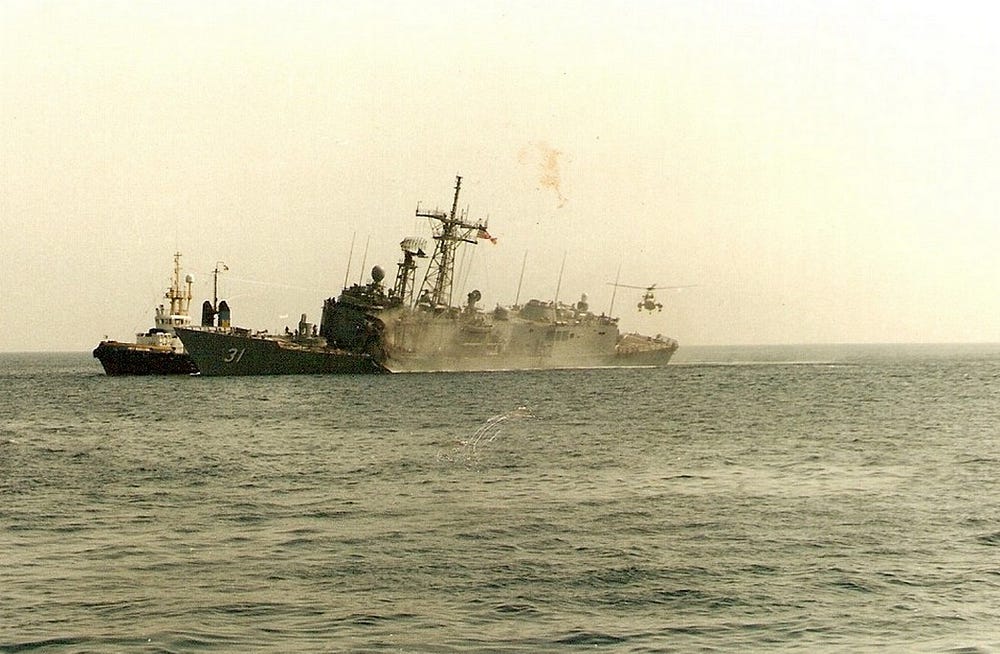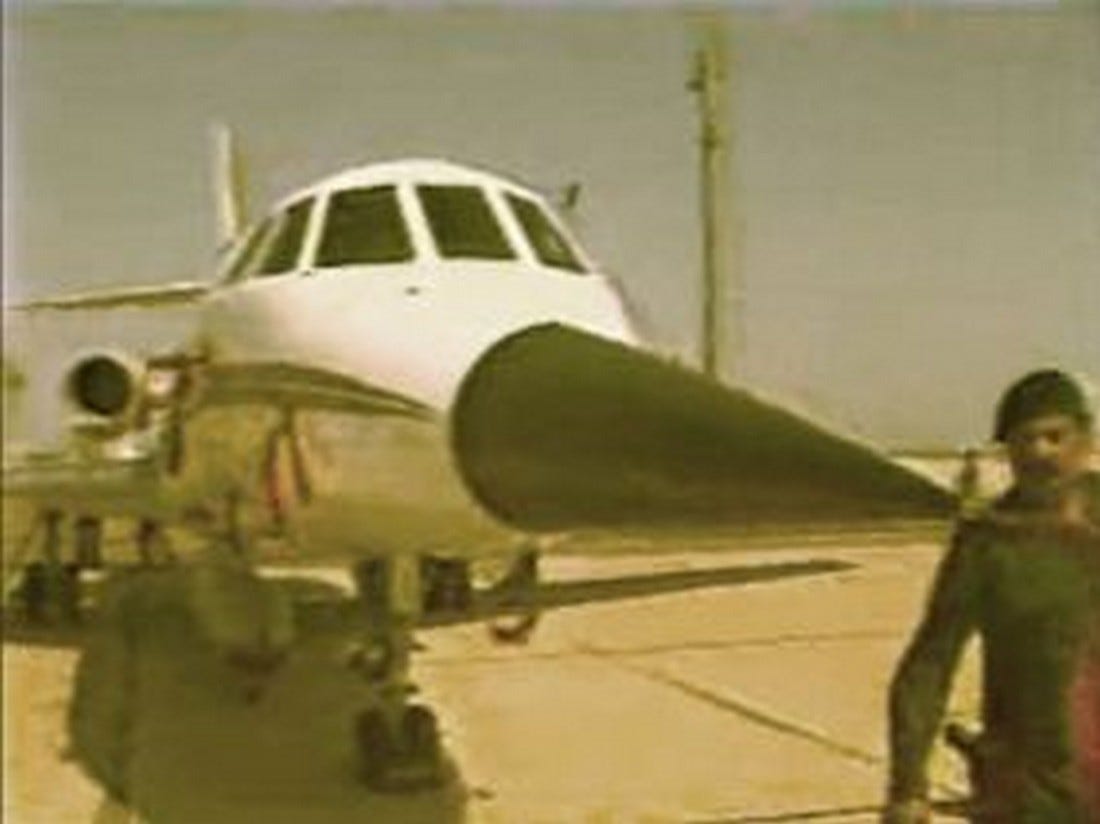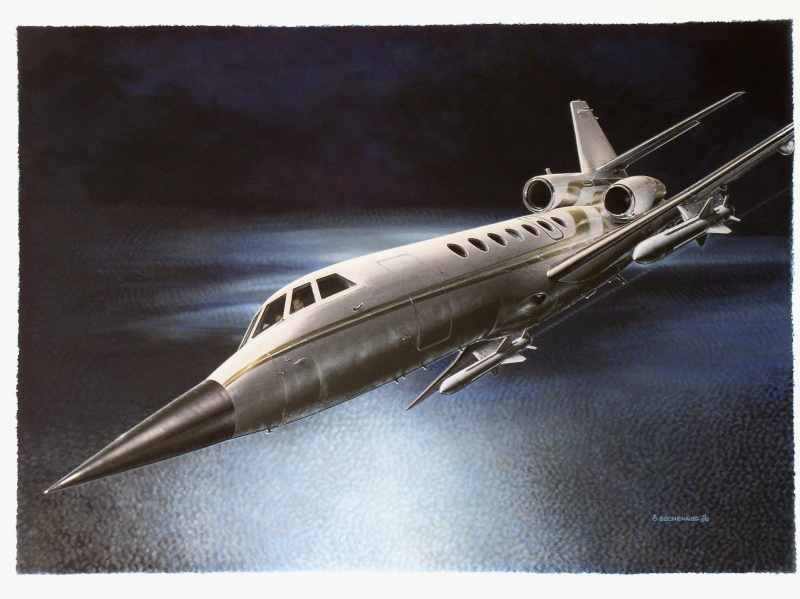
Posted on 07/27/2016 10:22:54 AM PDT by sukhoi-30mki

USS ‘Stark’ as seen from USS ‘Conyngham’ on the morning of May 18, 1987, listing heavily to port. USS ‘Conyngham’ Association photo
On May 17, 1987, the U.S. Navy guided missile frigate USS Stark was on a patrol in the central Persian Gulf, about three kilometers outside the Iraq-declared war-zone off the coast of Iran.
Around 22.00hrs local time, Stark came under attack from an Iraqi air force fighter jet. Radars on the U.S. warship tracked the aircraft as it approached, and Capt. Glenn R. Brindel ordered his radioman to issue a warning and request the pilot to identify himself.
The Iraqi did not respond. Instead, he approached to a range of 35 kilometers and fired two Aerospatiale AM.39 Exocet anti-ship missiles.
Stark’s radars failed to detect the incoming missiles and thus the crew realized much too late that it was under fire. Underway at an altitude of only three meters and guided by their relatively simple active-radar homing heads, both missiles aimed for the part of the ship with the highest radar cross-section.
The first penetrated the hull directly under the bridge. It failed to explode but its unspent rocket fuel ignited and sparked a raging fire. The second Exocet hit almost the same spot and detonated, tearing a three-meter by 4.6-meter hole in the hull.
Combined, the two missiles inflicted massive damage and ignited a conflagration that burned for almost 24 hours. In order to prevent his ship from sinking, Brindel ordered the flooding of the starboard side of the ship, thus keeping the hole on the port side above water.
Supported by the destroyers USS Waddell and USS Conyngham, the ship barely managed to reach the port of Manama in Bahrain the next day. The destroyer tender USS Acadia affected temporary repairs.
Twenty-nine U.S. Navy personnel died in the initial explosion and fire, two of whom were lost at sea.
Eight others died of their injuries, while 21 were injured. The Navy’s incident review board relieved Brindel of command and recommended him for court-martial. Eventually he received non-judicial punishment and retired early.
How could it happen that an Iraqi aircraft attacked Stark, and what could have been the motives and orders of the pilot, have remained unclear ever since.
Baghdad claimed that the warship was underway within what it declared a war-zone, but subsequently apologized, anyway. “The pilot mistook Stark for an Iranian tanker,” the Iraqi government stated.
While not entirely trusting this version, the U.S. government never punished Iraq for the attack — Washington accepted the apology and actually assigned blame to the Iranians, instead. Official attempts to meet and interview the pilot that flew the attack failed, despite Saddam Hussein’s promises of full access.’
Some well-positioned U.S. military sources described the pilot as “green.” Combined with unsubstantiated rumors regarding an “erratic flight plan,” this bolstered Baghdad’s official explanation that the attack was a mistake.
And then there was the mystery of the attacking plane itself. U.S. intelligence was convinced that an Iraqi Mirage F.1EQ fighter-bomber, overloaded with two AM.39 Exocets, would be sluggish and hard to fly.
Birth of an idea
The chain of events that led to the attack on Stark began in early 1986. Following a series of Iraqi air force strikes on their main oil-exporting terminal on Khark Island, the Iranians decided to reorganize their entire system of oil exports.
Instead of letting tankers chartered by foreign customers expose themselves to further Iraqi air strikes, the Iranians chartered a number of tankers on the international market and used these to shuttle crude from Khark to a new export terminal on Sirri Island in the lower Persian Gulf.
This organization seemed to offer plenty of advantages. Sirri is more than 750 kilometers from the nearest Iraqi air force base and was thus considered beyond Iraq’s reach. Furthermore, the tankers that took part in this shuttle system were crewed by professionals experienced in navigating dangerous waters around Khark — and well-trained in fighting fires and other effects of missile attacks.
Finally, Tehran expected that such ships could be better protected by interceptors of the Islamic Republic of Iran Air Force and warships of the Islamic Republic of Iran Navy.
The Iranian decision took the Iraqis by surprise.
Iraqi military intelligence realized that there was a surge in Iranian oil exports, and needed several weeks to find out why.
Once the intelligence came in about the new export terminal at Sirri, the Iraqi air force decided to attack. But that was easier said than done. In order to knock out the new terminal, pilots needed some idea what to aim for.
However, nobody in Iraq knew what Sirri looked like, nor what kind of terminal and air defenses to expect there. Furthermore, calculating the range to Sirri, the IRAF concluded that even its MiG-25RB Foxbat reconnaissance fighters couldn’t reach the island.
Attempting to surveil or attack the island with Mirage F.1EQs was risky. It might betray a well-guarded secret — that the Iraqi air force operated two Mirage F.1 variants, the F.1EQ-4 and F.1EQ-5, equipped for in-flight refueling.
Midway through related discussions at the Iraqi air force headquarters in Baghdad, the Iraqi Intelligence Service learned about the plan. So it happened that three of IIS’ officers walked into the headquarters and requested a meeting with the commander of the Iraqi air force, Maj. Gen. Hameed Sha’aban.
The intelligence officers made Sha’aban an offer he couldn’t refuse. The IIS had a Dassault Falcon 50 business jet configured as VIP transport and operated by its own crew. Their idea was to install reconnaissance cameras in this aircraft and then fly a clandestine sortie over Sirri Island, mimicking one of the many airliners moving along local commercial corridors.
Sha’aban accepted this idea and few days later, the Falcon 50 in question — serial number 122 , wearing Iraqi Airways markings and the civil registration YI-ALE — took off from Amman International in Jordan, carrying the usual crew of two plus three experienced Mirage pilots disguised as wealthy Arab businessmen.
Underway to Mumbai in India, it passed about 30 kilometers west of Sirri — just close enough for one of the Iraqis to take photos using a hand-held camera with a powerful optical zoom. The spies repeated the same procedure on the way back to Amman, a day later.

A Mirage F.1EQ-5 — serial number 4560 — seen during pre-delivery testing in France. Notable is one AM.39 Exocet missile painted in white, with its seeker-head section in orange. AMD photo
An urgent order
The resulting photographs enabled the Mirage pilots of No. 81 Squadron to launch a successful raid on Sirri on Aug. 12, 1986. Moreover, the affair inspired fresh thinking in the top ranks of the Iraqi air force.
One idea was to use a modified business jet to reach deep into the Persian Gulf entirely unmolested by Iranian interceptors. Furthermore, Iraqis expected that a larger aircraft would be suitable for carrying two AM.39 Exocets and thus might deliver a more powerful punch against supertankers loading crude at Iranian terminals.
This was something that appeared very important to Iraqi planners, as the sole Mirage F.1EQ variant equipped with Exocets available to the Iraqi air force at that time, the F.1EQ-5, could carry only one such missile.
And the Iraqis’ experience using AM.39s against tankers in the period 1980 to 1986 had showed that these large ships were not only quite survivable — only four merchants were outright sunk by Exocets during eight years of war — but also that a large number of Exocets were either decoyed by Iranian countermeasures, malfunctioned or failed to detonate even when they did hit their targets.
Claiming they needed a training aircraft for their Mirage F.1EQ-5 pilots, the Iraqis asked French firm Thales — the Iraqis’ primary contractor for all Mirage-related orders — to modify the Falcon 50 YI-ALE with the radar and weapons system of that Mirage variant.
Let the bird fly
Always eager to satisfy what was then a major export customer for their arms, the French worked fast. All the conversion work was completed by January 1987.
Initial test flights by Iraqi pilots revealed a number of glitches, but the French scrambled to rectify all of these and YI-ALE was delivered to Iraq on Feb. 9, 1987 via Corsica, southern Italy, Greece and Turkey. Among the pilots of No. 81 Squadron — the Iraqi air force’s sole unit flying Exocet-equipped Mirage F.1EQ-5s — the Falcon 50 became known as “Susanna.”
Following additional training-flights in Iraq, Susanna was prepared for its ultimate test — its first combat sortie. Early on May 17, 1987, one of the pilots from No. 81 Squadron — let’s call him “Maj. Muhammad” for the sake of convenience, because the current situation in Iraq precludes divulging his identity — re-deployed Susana from Saddam air base, better known in the United States as Qarayyah West, to Wahda air base, the former RAF Shoibiyah situated 45 kilometers southeast of Basra.
There, armorers equipped Susanna with two AM.39 Exocets.
Once the aircraft was ready, the crew began the long wait for their further orders. Shortly after the nightfall, the headquarters at Wahda air base received the coded message, “Let the bird fly,” which authorized the crew to fly an operational sortie over the Persian Gulf — in the same fashion Iraqi-operated Mirage F.1EQ-5s used to do.
Flying south through a pitch-black night, Maj. Mohammad took the usual course along what Iraqi air force pilots called “Mirage Alley,” a fictitious aerial corridor parallel to the Kuwaiti and Saudi coasts that runs all the way down to a point north of Bahrain. Then he made a 90-degree turn left toward Iran.
Approaching the Iraq-declared exclusion zone, Mohammad re-checked his position on a map and then activated his radar, initiating the search for any large surface target. Before soon, a blip appeared on his radar screen. From experience, he could say the target was a medium-size naval vessel underway along the edge of the prohibited zone, and looking as though it were about to enter it.
Mohammad concluded that the skipper of the ship in question played it smart — that he attempted to navigate along the very edge of the exclusion zone in order to avoid coming under attack. That is what prompted him to engage.
His Exocets were already hot — powered up and receiving targeting data from Susanna’s radar and weapons system — and thus ready. Mohammad flipped the cover on the stick and pressed the red trigger. He immediately sensed the heavy missile separating from the underwing pylon and heard the cracking sound of the rocket motor. A bright flash appeared in front of his aircraft, extending away and turning slightly toward the target.
By that point in time, Mohammad was a seasoned veteran with more than 1,000 hours in combat, mostly in Mirage F.1EQs. He had already fired dozens of Exocets in combat, also by night, and thus this mission wasn’t very different than his earlier experiences.
What was different about this mission however, was that Susanna was carrying two missiles.
Correspondingly, Mohammad repeated the targeting procedure and fired another AM.39 before making a sharp turn to the left, returning to a northern course and heading for the safety of Wahda air base.
ost scriptum
Maj. Mohammad didn’t know that he fired two missiles at a U.S. warship. He also did not know that his flight was being tracked by a U.S. Air Force E-3A Sentry radar early-warning aircraft flying over Saudi Arabia, the crew of which — upon learning about attack on Stark — asked two F-15 Eagle interceptors of the Royal Saudi Air Force to intercept and force him to land.
The Saudis declined.
While Mohammad continued a successful career with the Iraqi air force, Susanna never flew in combat again. Although Iraqis suspected that U.S. intelligence knew it was a modified Falcon 50 business jet that holed a well-armed and well-protected frigate and killed 37 American personnel, they never revealed its existence, because this would have contradicted the version of the affair the Iraqi foreign ministry had sold
In his annual review, Heyne sLater in 1987, the French began delivering the Mirage F.1EQ-6s to Iraq. This was the first variant capable of carrying two Exocets. A year later, the modified Falcon 50 received a further upgrade, which resulted in the installation of an additional fuel tank inside the cabin and a hard-point under the fuselage.
The latter made her capable of carrying the French-made Harold sideborne-looking-radar — a few of which were delivered to Iraq together with Mirage F.1EQ-6s in early 1988. In this fashion, Susanna was able of reaching the eastern Mediterranean Sea when flying from Saddam air base and carrying two Exocets on an attack or reconnaissance mission.
However, no No. 81 Squadron crew ever flew such a mission. During the Gulf War in 1991, the Iraqi air force decided to send Susanna away in an attempt to save the precious aircraft. Susanna flew to Iran … and hasn’t been seen in public since.

The last appearance of Susanna. In 1989, Iraqi National T.V. aired a short documentary showing the modified Falcon 50 including the nose with a Cyrano IVM radar, a Harold pod under the centerline and one Exocet anti-ship missile under each wing. Iraqi National T.V. capture
Oh fer key-rist sakes.
This is nonsense.
Propaganda.
Why is it spewed here is a reflection of just how some really gullible people will buy into any conspiracy, no matter how inane.
(Same Iranians that strapped a Hawk missile to a jet and called it is functional).
Sheesh.
Iraq was our ally at the time. A rogue pilot. It might have been the planx missile system was not working so the ship had no business being there.
Iraq was our ally at the time. A rogue pilot. It might have been the planx missile system was not working so the ship had no business being there. I do believe the captain of the ship was taking a leak at the time.
As I’ve stated several times before with regard to my posts, I don’t agree with or believe everything in my posts. And I don’t think I really owe an explanation to anyone other than the mods.
Jihad?
Pro-Russian ... yawn! Trolling for classified information? Well, please let me know how the pay is — I’d love to switch careers.
Your name tells it all.
Posting something that is on-its-face-colossally ignorant is more than silly.
Post info or articles with some credibility and this thread is well below your usual pro-Russian/pro-indian nonsense and hurts your credibility.
Oh yes, I guess I should run my posts through with you before uploading.
Would be nice.
Cheers.
Actually Sukhoi’s name shows the pro-indian side (who are our allies). Haven’t seen anything particularly pro Russian. Mostly he is just pro military hardware. Also if you READ this you would realize the ‘nonsense’ ‘propaganda’ is Iraq and not Iranian as you state.
If it was propaganda they would claim they modded the Falcon instead of having the French do it for them. And what part do you think is propaganda? That the Stark got hit? That is a matter of public record. How many missiles a Mirage 1.EQ can carry? That is also public record. The only thing new claimed here is that they used a Falcon and not a Mirage. Which does not seem at all outrageous. If they wanted to BS why not claim their Mirages can magically carry more missiles and fly extra far? That is more likely to scare opponents. And why would anyone spew pro Iraq propaganda. The original country is gone and what is left doesn’t have any Mirages.
So far nothing you have said on this thread makes any sense. Please avoid military hardware threads from now on, as well as other threads you know nothing about.
I don’t understand why the Skipper was relieved, except that there had to be someone to blame and blaming the Iraqis was not an option.
Next thing you know we will be hearing from deluded crazy whackobirds
that some air force mounted 7.62 miniguns in a C47 passenger compartment and circled around with the guns firing sideways
at the ground to support their infantry. Ridiculous!
BTW Hulka, since it was not a Falcon bizjet just what kind of airplane
was it that hit the Stark with two Exocets?


Good find. Very believable. At the time the Iraqis had suffered heavy tank losses in a failed offensive against Iran due to Iranian TOW missiles acquired from the Iran-Contra, Hez’bollah hostage release deal.
Disclaimer: Opinions posted on Free Republic are those of the individual posters and do not necessarily represent the opinion of Free Republic or its management. All materials posted herein are protected by copyright law and the exemption for fair use of copyrighted works.